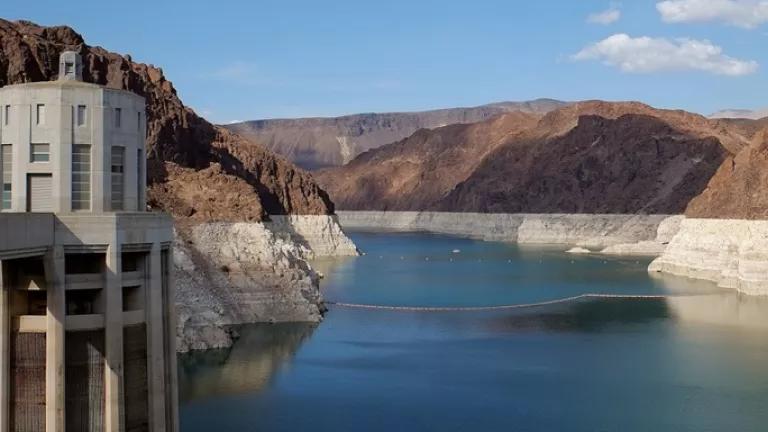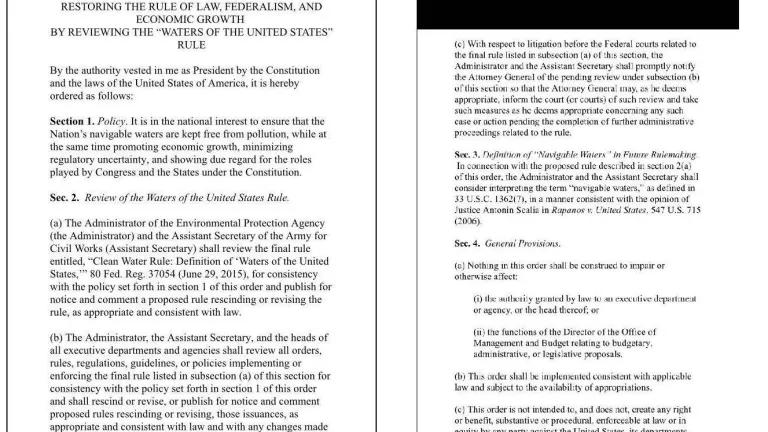
Today, President Trump signed an executive order directing the Environmental Protection Agency and the Army Corps of Engineers to begin repealing the Clean Water Rule, a landmark measure many years in the making. Likewise, new EPA Administrator Scott Pruitt recently told Fox News that he plans to go “full speed ahead” to attack the rule. The President’s order and Administrator Pruitt’s happy obedience insult all Americans―especially the 117 million of us who get drinking water drawn from streams the rule would help protect from pollution.
Axios political reporter Jonathan Swan obtained and tweeted an image of the order as it is expected to read, which I've posted below.
We rely on clean water for drinking, to irrigate crops, for swimming and fishing, and as habitat for wildlife. Wetlands and other waters reduce flooding and filter pollution. Since 1972, the Clean Water Act, one of our earliest and most important environmental laws, has helped restore and protect our Nation’s waters. The rule aimed to ensure that water bodies that perform these essential functions warrant protection from pollution and destruction under the Clean Water Act.
Although the Trump administration has targeted the Clean Water Rule for repeal, today's action does not kill it. Repealing a rule requires a full public process. It has to be justified by the law and the evidence available. That’s going to be rough sledding for the new administration, because the rule relies on an extensive scientific record and its protections are easily consistent with what Congress required in the Clean Water Act. Moreover, in the public process that the agencies must follow, citizen groups will resist the Trump administration’s attack on these safeguards. After all, the rule received broad public support, and those concerned citizens’ voices deserve to be heard if the President wants to take back the protections for which they fought.
But for now, let’s look at why the rule is important, why industry-led complaints about it are overblown, and why it’d be a bad idea to undo it.
What does it mean for a water body to be protected by the Clean Water Act?
The Clean Water Act extends numerous protections to any water body deemed to be a “water of the United States.” Here are just a few:
- Wastewater dischargers and sewage treatment plants may not discharge into any such waters without pollution-limiting permits;
- Facilities storing significant quantities of oil near covered waters must develop oil spill prevention and response plans;
- States must identify and prepare plans to clean up protected waters that don’t meet state water quality standards;
- Industrial developers ordinarily must obtain a permit before discharging dredged or fill material into protected waters, and sometimes must mitigate their impact by creating, preserving, or enhancing other water resources;
- Nobody may discharge “any radiological, chemical, or biological warfare agent, any high-level radioactive waste, or any medical waste” into covered waters; and
- Entities disposing sewage sludge that could pollute such waters must abide by pollution control standards.
Why did EPA and the Corps adopt the Clean Water Rule?
For decades, the Clean Water Act was broadly applied to protect many kinds of waters, and water quality around the country improved markedly. In recent years, however, it became unclear whether some critical waters—especially small streams and wetlands—qualified for protection from pollution, degradation, or destruction. The uncertainty resulted from two Supreme Court decisions and agency practices implemented by the Bush administration.
As a result, implementing and enforcing the law became a mess, and federal law enforcement officials acknowledged that they had shifted their attention away from polluters in upstream areas, because it was hard to hold them accountable. This is like a police officer who only patrols Main Street and just hopes things are okay in other neighborhoods. According to a review by EPA enforcement staff, this uncertainty harmed an estimated 489 enforcement cases in just a short period of time. For example, in one case, according to EPA, a Texas dairy farm operator discharged as much as 43,000 gallons of wastewater onto his property, where it flowed to a neighboring property and then entered a creek that flowed into a large, navigable-in-fact waterway. Although EPA spent over 300 hours analyzing the case, the Assistant U.S. Attorney declined to prosecute because of concerns about establishing protection.
These inadequate safeguards particularly imperiled headwater, seasonal, and rain-dependent streams and wetlands throughout the country. I’d be hard-pressed to overstate the extent of these waters nationwide or the benefits these resources provide to society. Approximately 60 percent of the streams (roughly two million miles!) in the continental U.S. don't flow year-round, and one in every three Americans gets drinking water from public systems that draw supply from headwater, seasonal, and rain-dependent streams. Wetlands―most of which were at risk under the pre-rule regime―cover roughly 110 million acres in the lower 48 states, and those waters perform numerous functions; for example, an acre of wetlands can store upwards of a million gallons of flood water.
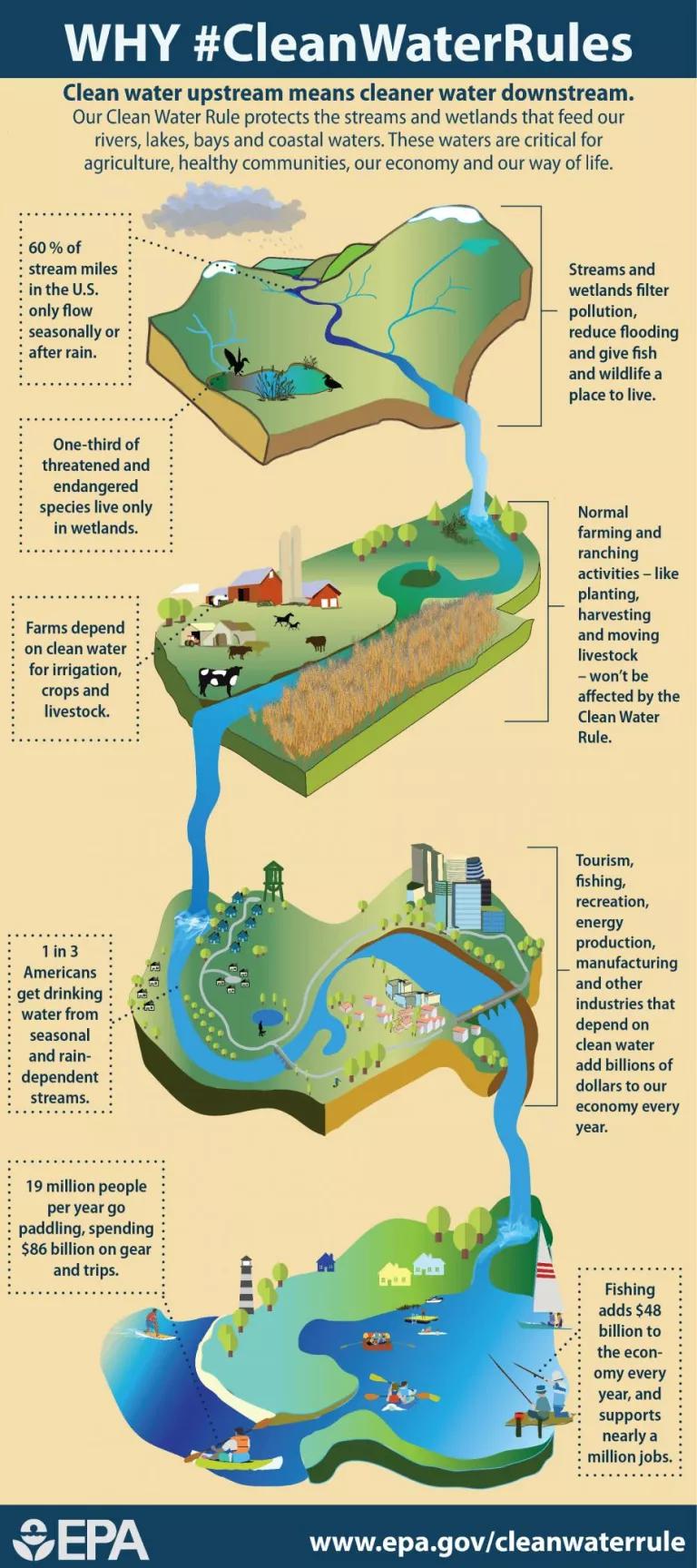
What does the rule actually do?
I described the rule in detail in a post when the rule was signed. In brief, the rule deals with water bodies in three ways:
- Guaranteed protection: The rule does not change the longstanding protections for waters that can float a boat, coastal waters, interstate waters, and impounded waters (like reservoirs behind dammed rivers). Most importantly, the rule restores guaranteed protections that federal clean water rules used to ensure for tributaries and wetlands and ponds that are adjacent to other covered waters.
- Case-by-case protection: For certain waters not considered adjacent, the rule would allow for their future protection based on an analysis whether they significantly impact downstream water conditions in the watersheds in which they're located.
- Exempt: The rule exempts a long list of features from being covered by the law, namely things that the agencies have determined are less important to treat as protected because they are less relevant to downstream water quality. This includes some of the bogeymen that the opponents of the rule have claimed would've been covered by the proposal, absurdly including puddles, but also some features that NRDC and our partners disagreed with the agencies about.
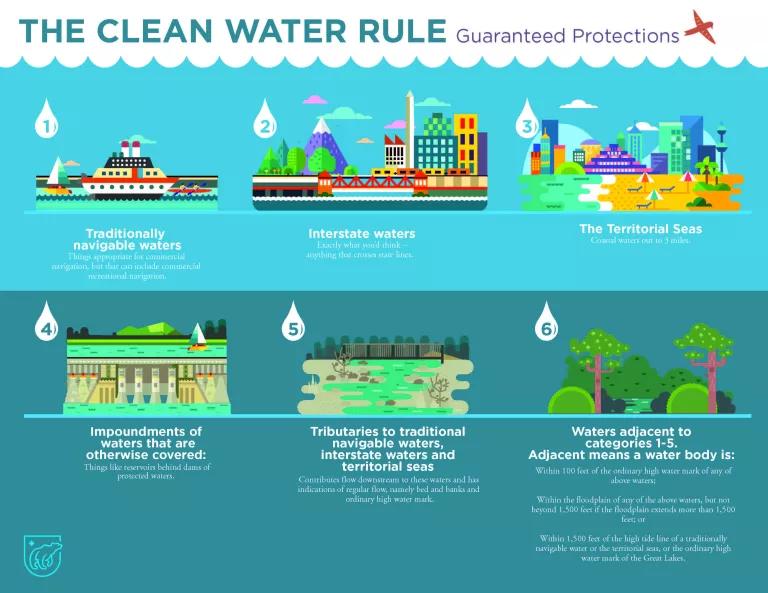
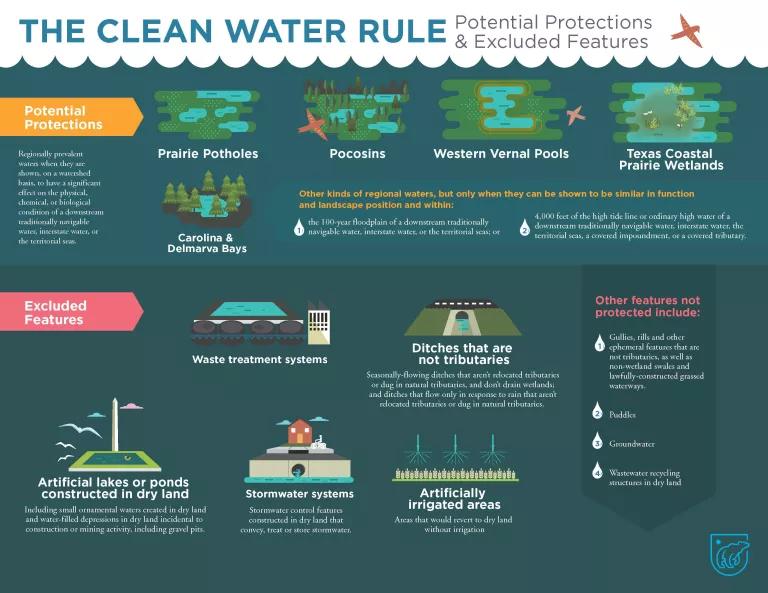
I hear this rule is a big agency “overreach.” Is it?
Not by a long shot.
The rule directly responds to widespread confusion and to numerous calls from all sectors for clearer rules. But the agencies didn’t just invent the categories of waterways to be covered; instead the rule relies on the law itself, the Supreme Court’s decisions, and―critically―a robust scientific record.
For starters, the rule’s protections fit easily within the law. Although industry lobbyists have spilled a whole lot of ink over what the Supreme Court’s decisions mean, the federal appeals courts implementing the decisions uniformly agree that the Clean Water Act covers―at a bare minimum―those categories of water bodies that collectively or individually have a significant influence on the chemical, physical, or biological condition of navigable and interstate waters downstream.
Against this legal backdrop, EPA produced an extensively peer-reviewed scientific report examining the ways that upstream and downstream waters are connected to one another. That analysis confirmed the common-sense understanding that tributaries and nearby waters, including small ones and ones that don’t have surface water in them year-round, have multiple and enormously important impacts on downstream water quality. It also found that waters without a surface connection to the tributary network also can have significant effects downstream, and that the strength of those connections could be assessed for particular watersheds.
Consequently, the science clearly supported providing guaranteed coverage to tributaries and adjacent waters, as the rule does. Although NRDC and several of our partners argued that the evidence also warranted guaranteed protection for many so-called “isolated” waters, the agencies took a more conservative approach and required case-by-case analysis for such water bodies.
Because it protects important resources, the rule was estimated to lead to public benefits (not all of which could be quantified) as high as $572 million per year, a figure that would outweigh the rule’s expected costs.
Okay, but the agencies didn’t consider input on the rule, right?
This is another bogus claim. The agencies took comment on the proposal from April 21-November 14, 2014, a long comment period that itself followed years of public engagement on potential new policy guidelines and on the scientific report. Before issuing the final rule, EPA met with hundreds of stakeholders (summarized here, here, and here) and received more than a million comments, roughly 87% of which supported the proposed rule.
In light of the significant benefits of the rule and the rigorous process the agencies undertook, it should come as no surprise that restored clean water protections enjoy broad support. A nationwide poll for the League of Conservation Voters found that 80% of respondents supported the rule. In polling for the American Sustainable Business Council, 80% of small business owners said they supported the then-proposed Clean Water Rule. Similarly, a bipartisan research team polled hunters and anglers nationwide and discovered that 83% thought EPA should apply the rules and standards of the Clean Water Act to smaller headwater streams and wetlands, with strong support across the political spectrum for the policy.
Why would the Trump administration attack science-based, popular, and legally-justified protections?
The reason is simple―curbing water pollution costs dischargers money, and this administration prioritizes the bottom line of big business over public health and the environment.
Industrial polluters to which the administration listens have long opposed the Clean Water Act (and this rule along with it) and several powerful industrial lobby groups specifically asked for the rule’s repeal. On February 23, for instance, as President Trump and his advisors held closed-door meetings with two dozen CEOs of large corporations, the Business Roundtable sent the White House a letter that included a request to undo the Clean Water Rule.
In addition, the administration’s emerging regulatory policy reveals a deeply disdainful attitude towards public protections and the benefits they deliver. White House advisor Steve Bannon told a gathering of conservative activists that a centerpiece of the Trump administration’s policy is the “deconstruction of the administrative state,” a policy that he said was demonstrated by the administration’s appointees. One such appointee, EPA Administrator Scott Pruitt, so despises federal environmental protections―including the Clean Water Rule―that he sued the agency he now leads on numerous occasions to weaken public safeguards.
In the same vein, the President has taken several actions already that misrepresent the costs of Obama-era regulations and ignore the benefits of public safeguards. Most egregiously, he signed an illegal executive order that irrationally and irresponsibly requires the repeal of two regulations for any new one, and which entirely ignores the benefits of such rules in accounting for their impacts. Likewise, in signing a bill repealing a Department of Interior rule strengthening requirements for monitoring and preventing pollution of streams harmed by coal mining, the President claimed it “will eliminate another terrible job-killing rule, saving many thousands of American jobs,” when the agency's actual economic analysis of the rule found that it would lead to a net increase of jobs, and would have insignificant impacts on electricity costs.
Is there anything else noteworthy about the Executive Order?
Although it’s bad enough that the executive order targets the rule for potential repeal, President Trump’s order contains several additional troubling elements.
First, the order lays out a policy that “[i]t is in the national interest to ensure that the Nation’s navigable waters are kept free from pollution,” without clarifying what that means for the vast majority of the country’s waterways where a boat can’t float. Water bodies serve critical functions regardless of whether they can be navigated, as many anglers will tell you.
Second, a directive in the order could diminish clean water protections to make them significantly weaker than even the under-protective Bush administration policies. The order tells the agencies to “consider interpreting” the Clean Water Act “in a manner consistent with the opinion of Justice Antonin Scalia” in the most recent Supreme Court case addressing this issue. That opinion, if followed, would disable federal pollution safeguards for streams unless they are “relatively permanent,” and exclude wetlands that don’t have a “continuous surface connection” to other covered waters. The implications of that are astonishing for the roughly 60% of streams that don’t flow year-round, and the countless wetlands – likely the majority of the 110 million acres of wetlands in the continental U.S. – that don’t connect to “relatively permanent” waters. And not only is that an incoherent and unscientific environmental policy, it also doesn't pass the legal laugh test, as Justice Scalia’s opinion was rejected by a majority of the Supreme Court.
Finally, the order directs EPA and the Corps to propose a rule “rescinding or revising” the Clean Water Rule, which makes it sound like keeping the rule’s protections in place is not an option on the table, and directs the agencies to “notify the Attorney General of the pending review” of the rule so that he “may, as he deems appropriate, inform the court (or courts) of such review and take such measures as he deems appropriate….” Taken together, those orders strike me as a none-too-subtle message: the federal government should do whatever it can to stand down from its defense of the existing rule in the now-pending litigation. That puts the administration at odds with what EPA, the Army Corps, and the Department of Justice told a federal appeals court just last month, when the agencies filed their brief in support of the rule in the U.S. Court of Appeals for the Sixth Circuit. In that litigation, the agencies staunchly defended the rule on the science and the law, saying: “The Clean Water Rule is a carefully tailored response to Supreme Court precedent, peer-reviewed science, and the Agencies’ long experience in implementing the Act.”



